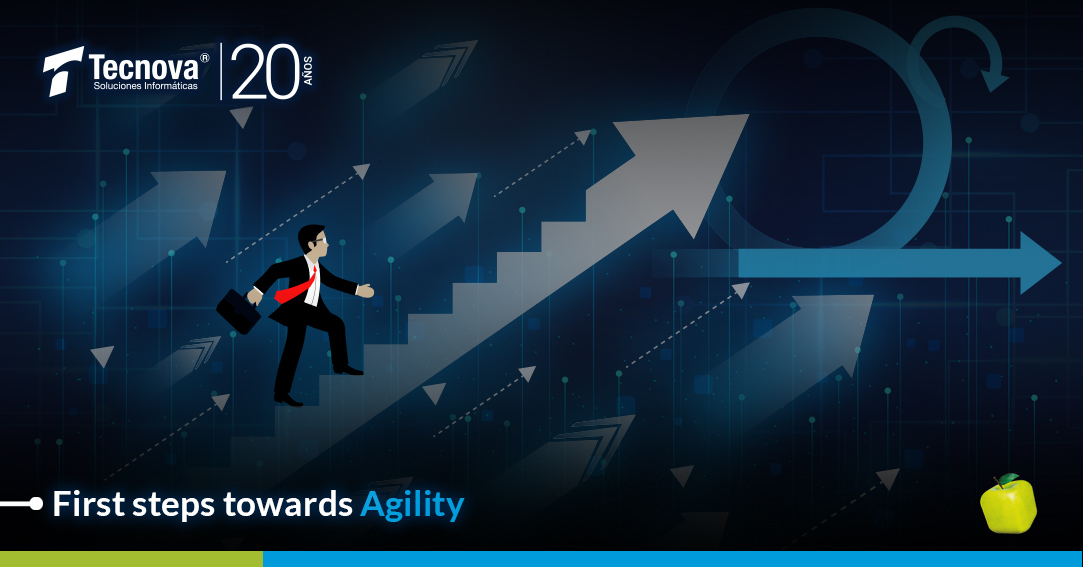First steps towards Agility

We’ve heard a lot of agility. Above all, with ideas linked to the speed of processes. However, that is the wrong concept. “It is believed that agility is to deliver the work faster,” says Felipe Urzúa, Sales Engineer from Tecnova. He goes all the way before “dipping” customers into agile development.
In a scenario with vague ideas about the agile, Tecnova wants to help you. In this note, expert Felipe Urzúa will address everything that needs to be known before developing software with an agile practice.
Methodology or practice What do customers know about agility?
This is common when a development project starts. Customers already have a mock-up of what they require, but it isn´t always accurate. According to Urzúa, almost 80% of customers request development in an agile manner. “‘I want to work with agility,’ they tell us, but they don’t know clearly what agility is,” he says.
According to Felipe Urzúa, before starting any induction on agility he encounters two situations: When the client asks to work with agility, but has a project that does not meet those standards and, when the client wants to “work with agility, it´s really willing to, but doesn’t have the experience,” the engineer emphasizes.
This first diagnosis serves to know what people understand by Agile. With this, Felipe emphasizes that there is misconception about what agility is, a method, a philosophy, a practice? “Agility is not a methodology, […] are practice, like activities you can pick up. You can have a project that is not agile and have agile practices independently,” he says.
Start techniques at the Agile
In Tecnova, a series of inductions are developed to explain the customer about everything related to Agile. One of the methods used are the Workshop on agility. They are attended by people form trained in IT and software development, to analysts in marketing, operations, among others. The idea is that the entire company team will get involved in the software project with agile practices, to fully understand what implications this approach has.
To get to that knowledge, there are several activities to discover the product that the customer requires and the best way to apply agility. As Felipe Urzúa says, the fundamental thing is to raise awareness of what it means to be Agile, its role and how to help the initiative succeed through practices such as the Agile 101. The concept summarizes a brief introduction to the principles and practices of agile development.
This step is very necessary since, according to the engineer, “today 80% of customers prefer agile […] and they come preset with a misconception or incomplete idea of agility.”
Faced with this, the fundamental thing is to talk to the client about their requirements, because “generally agile practices demand more participation from them. They don’t have to be technical experts or anything specific, they’re just required to participate and compromise,” he says.
Activities with Agile
After understanding the fundamentals of the agile, there is the necessary foundation to initiate alignment between the development company and the customer. In that exercise, the number of activities that will be performed in an agile manner can be defined. “We explain all the possible practices that we can apply, ranging from requirements discovery activities, functional specification, meeting instances, construction, testing, etc. as well as evaluated practices that need to be maintained.”, says Felipe Urzúa.
This is necessary, as customers will understand how an agile practice works. “We teach customers the agile practices to use, how they are applied and why to use them. In addition to the ROI provided by these practices , regardless of the activities that are done”. As Felipe Urzúa summarizes, at this stage “the process is “configured to determine how agile we will the company and customer be”..
The value of the agile
However, it’s not all about guidelines. The idea of introducing the agile concept in the client is to talk about the meaning and value that come with doing projects under these practices. “We try not only to talk about the methodology, but also how it impacts on the culture of the client and […] what is the gain of the agile, as it has nothing to do with delivering software every two weeks,” the engineer emphasizes.
In his words, the true value of the agile is when upon receiving the final software, “every line of code that is developed serves to solve something. That’s the real goal: not to waste money working on the code,” Felipe Urzúa says.








